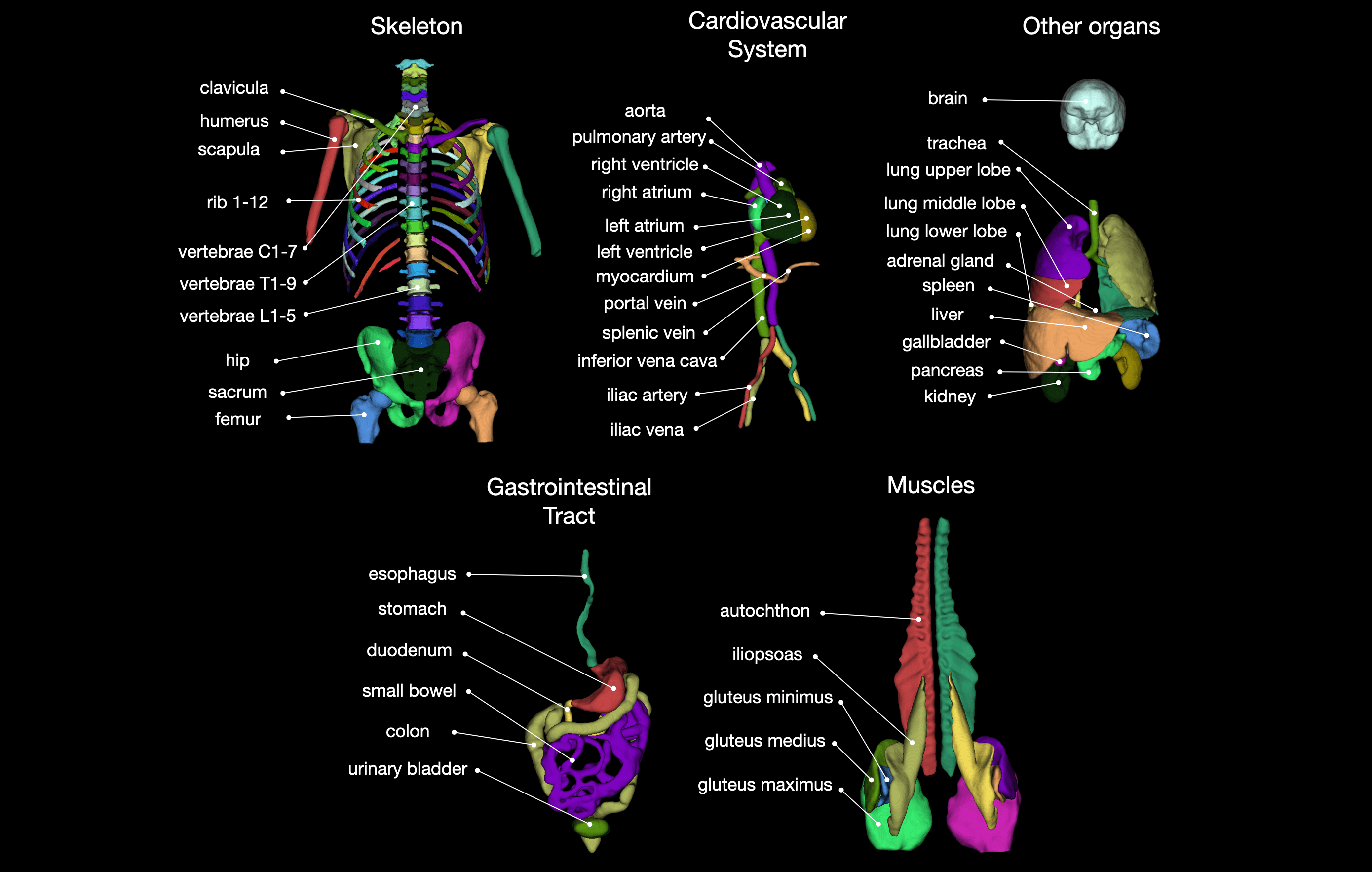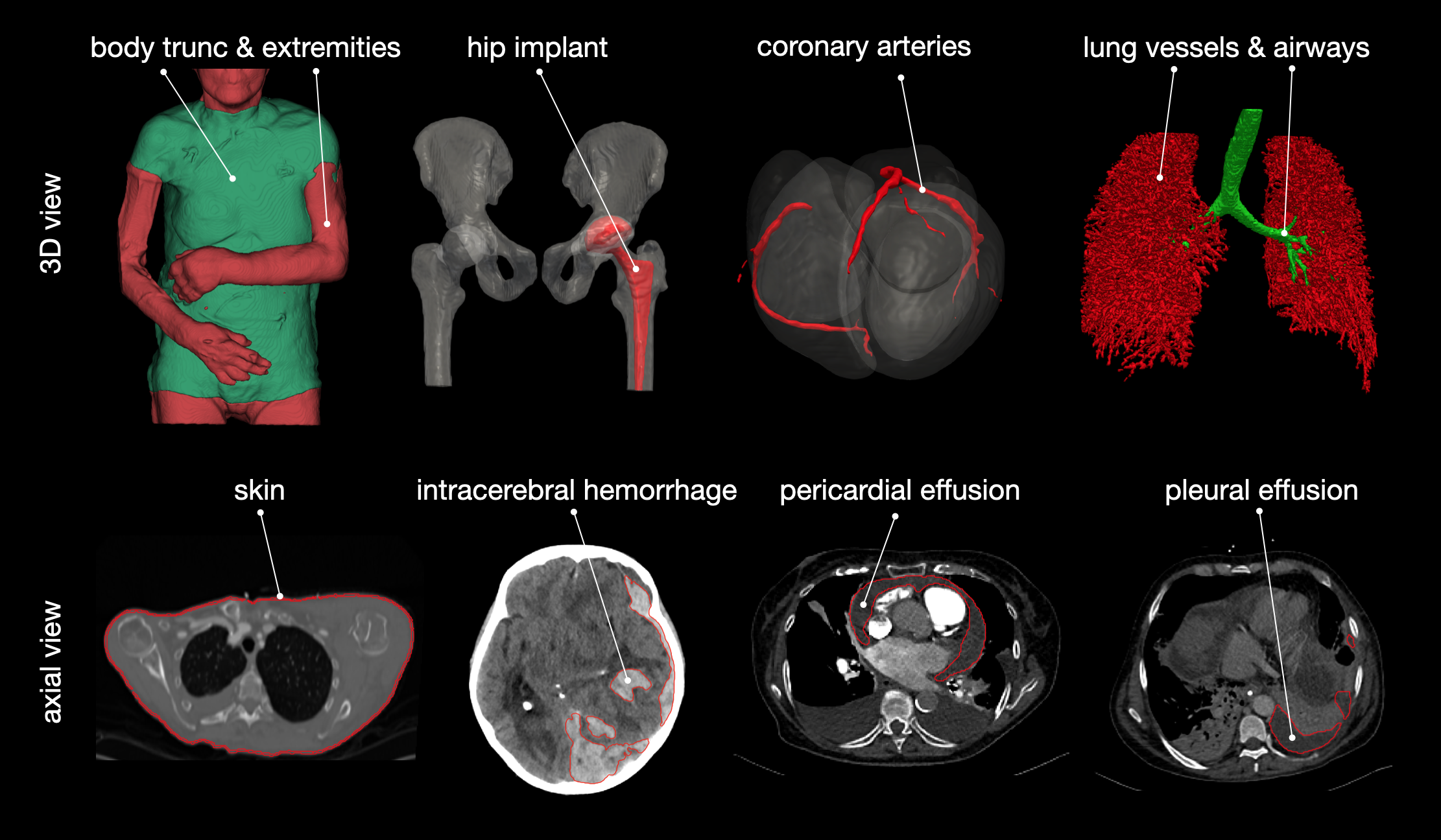Tool for segmentation of 104 classes in CT images. It was trained on a wide range of different CT images (different scanners, institutions, protocols,...) and therefore should work well on most images. The training dataset with 1204 subjects can be downloaded from Zenodo. You can also try the tool online at totalsegmentator.com.
Created by the department of Research and Analysis at University Hospital Basel.
If you use it please cite our paper: https://arxiv.org/abs/2208.05868. Please also cite nnUNet since TotalSegmentator is heavily based on it.
TotalSegmentator works on Ubuntu, Mac and Windows and on CPU and GPU (on CPU it is slow).
Install dependencies:
- Python >= 3.7
- Pytorch
- You should not have any nnU-Net installation in your python environment since TotalSegmentator will install its own custom installation.
optionally:
- if you input DICOM images and run on MacOS you have to install dcm2niix
- if you use the option
--previewyou have to install xvfb (apt-get install xvfb) - for faster resampling you can use
cucim(pip install cupy-cuda11x cucim)
Install Totalsegmentator
pip install TotalSegmentator
TotalSegmentator -i ct.nii.gz -o segmentations
Note: A Nifti file or a folder of DICOM images is allowed as input
Note: If a CUDA compatible GPU is available TotalSegmentator will automatically use it. Otherwise it will use the CPU, which is a lot slower and should only be used with the
--fastoption.
Note: You can also try it online: www.totalsegmentator.com (supports dicom files)
Note: This is not a medical device and not intended for clinical usage.
--fast: For faster runtime and less memory requirements use this option. It will run a lower resolution model (3mm instead of 1.5mm).--preview: This will generate a 3D rendering of all classes, giving you a quick overview if the segmentation worked and where it failed (seepreview.pngin output directory).--ml: This will save one nifti file containing all labels instead of one file for each class. Saves runtime during saving of nifti files. (see here for index to class name mapping).--roi_subset: Takes a space separated list of class names (e.g.spleen colon brain) and only saves those classes. Saves runtime during saving of nifti files.--statistics: This will generate a filestatistics.jsonwith volume (in mm³) and mean intensity of each class.--radiomics: This will generate a filestatistics_radiomics.jsonwith radiomics features of each class. You have to install pyradiomics to use this (pip install pyradiomics).
We added some more models to TotalSegmentator beyond the default one. This allows segmentation of even more classes in more detailed subparts of the image. First you have to run TotalSegmentator with the normal settings to get the normal masks. These masks are required to crop the image to a subregion on which the detailed model will run.
TotalSegmentator -i ct.nii.gz -o segmentations --fast
TotalSegmentator -i ct.nii.gz -o segmentations -ta lung_vessels
Overview of available subtasks and the classes which they contain.
Openly available:
- lung_vessels: lung_vessels (cite paper), lung_trachea_bronchia
- cerebral_bleed: intracerebral_hemorrhage
- hip_implant: hip_implant
- coronary_arteries: coronary_arteries
- body: body, body_trunc, body_extremities, skin
- pleural_pericard_effusion: pleural_effusion (cite paper), pericardial_effusion (cite paper)
Available after purchase of a license (free licenses possible for academic projects). Contact [email protected] if you are interested:
- bones_extremities: femur, patella, tibia, fibula, tarsal, metatarsal, phalanges_feet, humerus, ulna, radius, carpal, metacarpal, phalanges_hand, sternum, skull, spinal_cord
- tissue_types: subcutaneous_fat, skeletal_muscle, torso_fat
- heartchambers_highres: myocardium, atrium_left, ventricle_left, atrium_right, ventricle_right, aorta, pulmonary_artery (more precise heart chamber segmentation, trained on sub-millimeter resolution)
- head: mandible, teeth, brainstem, subarachnoid_cavity, venous_sinuses, septum_pellucidum, cerebellum, caudate_nucleus, lentiform_nucleus, insular_cortex, internal_capsule, ventricle, central_sulcus, frontal_lobe, parietal_lobe, occipital_lobe, temporal_lobe, thalamus, tyroid (trained on sub-millimeter resolution)
- aortic_branches: brachiocephalic_trunc, subclavian_artery_right, subclavian_artery_left, common_carotid_artery_right, common_carotid_artery_left, brachiocephalic_vein_left, brachiocephalic_vein_right, atrial_appendage_left, superior_vena_cava, pulmunary_vein, tyroid
We also provide a docker container which can be used the following way
docker run --gpus 'device=0' --ipc=host -v /absolute/path/to/my/data/directory:/tmp wasserth/totalsegmentator_container:master TotalSegmentator -i /tmp/ct.nii.gz -o /tmp/segmentations
Totalsegmentator has the following runtime and memory requirements (using a Nvidia RTX 3090 GPU):
(1.5mm is the normal model and 3mm is the --fast model)
If you want to reduce memory consumption you can use the following options:
--body_seg: This will crop the image to the body region before processing it--force_split: This will split the image into 3 parts and process them one after another--nr_thr_saving 1: Saving big images with several threads will take a lot of memory
The exact split of the dataset can be found in the file meta.csv inside of the dataset. This was used for the validation in our paper.
The exact numbers of the results for the high resolution model (1.5mm) can be found here. The paper shows these numbers in the supplementary materials figure 11.
To aggregate results across subjects and classes the following approach was taken: For each class in each subject calculate the (Dice) score, then take the average of all scores (micro averaging). If a class is not present on an image (e.g. the brain is not present on images of the legs) then exclude this value from the calculation.
Note: The model was trained on unblurred images. The published training dataset, however, has blurred faces for data privacy reasons. Therefore, models trained on the public dataset cannot be directly compared to our pretrained model. In the future we plan to provide a version of our model which was trained on the public blurred dataset so people can compare to this as a baseline.
You have to download the data and then follow the instructions of nnU-Net how to train a nnU-Net. We trained a 3d_fullres model and the only adaptation to the default training is setting the number of epochs to 4000 and deactivating mirror data augmentation. The adapted trainer can be found here.
For combining the single masks into one multilabel file you can use the function combine_masks_to_multilabel_file in totalsegmentator.libs.
If you want to combine some subclasses (e.g. lung lobes) into one binary mask (e.g. entire lung) you can use the following command:
totalseg_combine_masks -i totalsegmentator_output_dir -o combined_mask.nii.gz -m lung
Normally weights are automatically downloaded when running TotalSegmentator. If you want to manually download the weights (download links see here) and copy them into the right directory so TotalSegmentator can find them use this:
totalseg_import_weights -i my_downloaded_weights.zip
You can run totalsegmentator via python:
from totalsegmentator.python_api import totalsegmentator
totalsegmentator(input_path, output_path)pip install git+https://github.com/wasserth/TotalSegmentator.git
When you get the following error message
ITK ERROR: ITK only supports orthonormal direction cosines. No orthonormal definition found!
you should do
pip install SimpleITK==2.0.2
TotalSegmentator (starting in v1.5.4) sends anonymous usage statistics to help us improve it further. You can deactivate it by setting send_usage_stats to false in ~/.totalsegmentator/config.json.
For more details see this paper https://arxiv.org/abs/2208.05868. If you use this tool please cite it as follows
Wasserthal J., Meyer M., Breit H., Cyriac J., Yang S., Segeroth M. TotalSegmentator: robust segmentation of 104 anatomical structures in CT images, 2022. URL: https://arxiv.org/abs/2208.05868. arXiv: 2208.05868
Please also cite nnUNet since TotalSegmentator is heavily based on it.
Moreover, we would really appreciate if you let us know what you are using this tool for. You can also tell us what classes we should add in future releases. You can do so here.
The following table shows a list of all classes.
TA2 is a standardised way to name anatomy. Mostly the TotalSegmentator names follow this standard. For some classes they differ which you can see in the table below.
| Index | TotalSegmentator name | TA2 name |
|---|---|---|
| 1 | spleen | |
| 2 | kidney_right | |
| 3 | kidney_left | |
| 4 | gallbladder | |
| 5 | liver | |
| 6 | stomach | |
| 7 | aorta | |
| 8 | inferior_vena_cava | |
| 9 | portal_vein_and_splenic_vein | hepatic portal vein |
| 10 | pancreas | |
| 11 | adrenal_gland_right | suprarenal gland |
| 12 | adrenal_gland_left | suprarenal gland |
| 13 | lung_upper_lobe_left | superior lobe of left lung |
| 14 | lung_lower_lobe_left | inferior lobe of left lung |
| 15 | lung_upper_lobe_right | superior lobe of right lung |
| 16 | lung_middle_lobe_right | middle lobe of right lung |
| 17 | lung_lower_lobe_right | inferior lobe of right lung |
| 18 | vertebrae_L5 | |
| 19 | vertebrae_L4 | |
| 20 | vertebrae_L3 | |
| 21 | vertebrae_L2 | |
| 22 | vertebrae_L1 | |
| 23 | vertebrae_T12 | |
| 24 | vertebrae_T11 | |
| 25 | vertebrae_T10 | |
| 26 | vertebrae_T9 | |
| 27 | vertebrae_T8 | |
| 28 | vertebrae_T7 | |
| 29 | vertebrae_T6 | |
| 30 | vertebrae_T5 | |
| 31 | vertebrae_T4 | |
| 32 | vertebrae_T3 | |
| 33 | vertebrae_T2 | |
| 34 | vertebrae_T1 | |
| 35 | vertebrae_C7 | |
| 36 | vertebrae_C6 | |
| 37 | vertebrae_C5 | |
| 38 | vertebrae_C4 | |
| 39 | vertebrae_C3 | |
| 40 | vertebrae_C2 | |
| 41 | vertebrae_C1 | |
| 42 | esophagus | |
| 43 | trachea | |
| 44 | heart_myocardium | |
| 45 | heart_atrium_left | |
| 46 | heart_ventricle_left | |
| 47 | heart_atrium_right | |
| 48 | heart_ventricle_right | |
| 49 | pulmonary_artery | pulmonary arteries |
| 50 | brain | |
| 51 | iliac_artery_left | common iliac artery |
| 52 | iliac_artery_right | common iliac artery |
| 53 | iliac_vena_left | common iliac vein |
| 54 | iliac_vena_right | common iliac vein |
| 55 | small_bowel | small intestine |
| 56 | duodenum | |
| 57 | colon | |
| 58 | rib_left_1 | |
| 59 | rib_left_2 | |
| 60 | rib_left_3 | |
| 61 | rib_left_4 | |
| 62 | rib_left_5 | |
| 63 | rib_left_6 | |
| 64 | rib_left_7 | |
| 65 | rib_left_8 | |
| 66 | rib_left_9 | |
| 67 | rib_left_10 | |
| 68 | rib_left_11 | |
| 69 | rib_left_12 | |
| 70 | rib_right_1 | |
| 71 | rib_right_2 | |
| 72 | rib_right_3 | |
| 73 | rib_right_4 | |
| 74 | rib_right_5 | |
| 75 | rib_right_6 | |
| 76 | rib_right_7 | |
| 77 | rib_right_8 | |
| 78 | rib_right_9 | |
| 79 | rib_right_10 | |
| 80 | rib_right_11 | |
| 81 | rib_right_12 | |
| 82 | humerus left | |
| 83 | humerus right | |
| 84 | scapula_left | |
| 85 | scapula_right | |
| 86 | clavicula_left | clavicle |
| 87 | clavicula_right | clavicle |
| 88 | femur left | |
| 89 | femur right | |
| 90 | hip_left | hip bone |
| 91 | hip_right | hip bone |
| 92 | sacrum | |
| 93 | face | |
| 94 | gluteus_maximus_left | gluteus maximus muscle |
| 95 | gluteus_maximus_right | gluteus maximus muscle |
| 96 | gluteus_medius_left | gluteus medius muscle |
| 97 | gluteus_medius_right | gluteus medius muscle |
| 98 | gluteus_minimus_left | gluteus minimus muscle |
| 99 | gluteus_minimus_right | gluteus minimus muscle |
| 100 | autochthon_left | |
| 101 | autochthon_right | |
| 102 | iliopsoas_left | iliopsoas muscle |
| 103 | iliopsoas_right | iliopsoas muscle |
| 104 | urinary_bladder |


